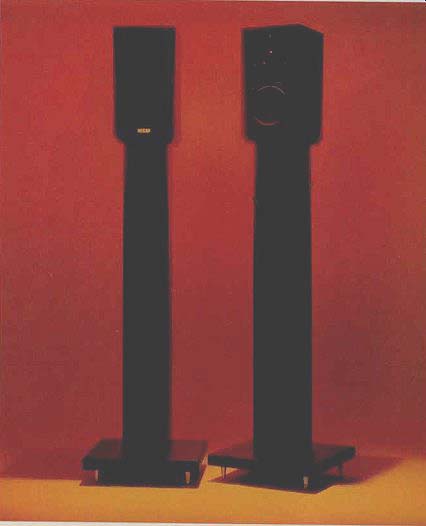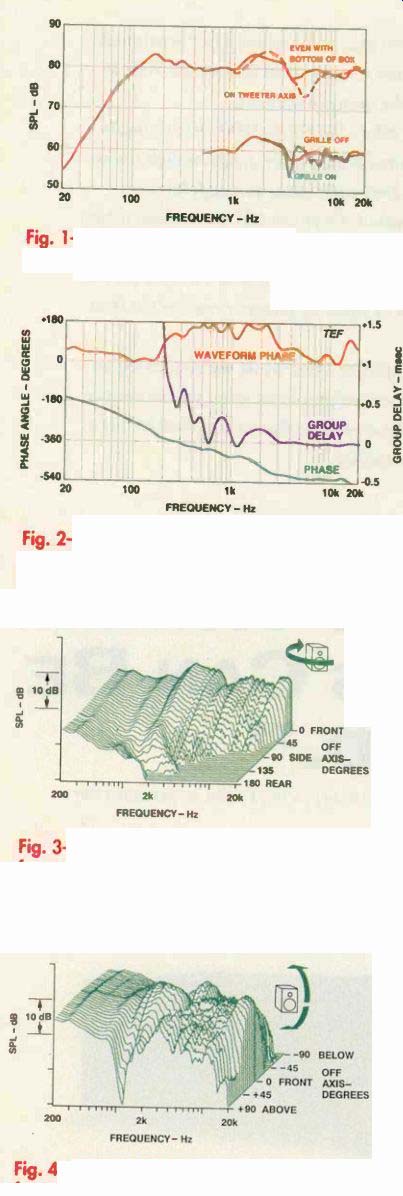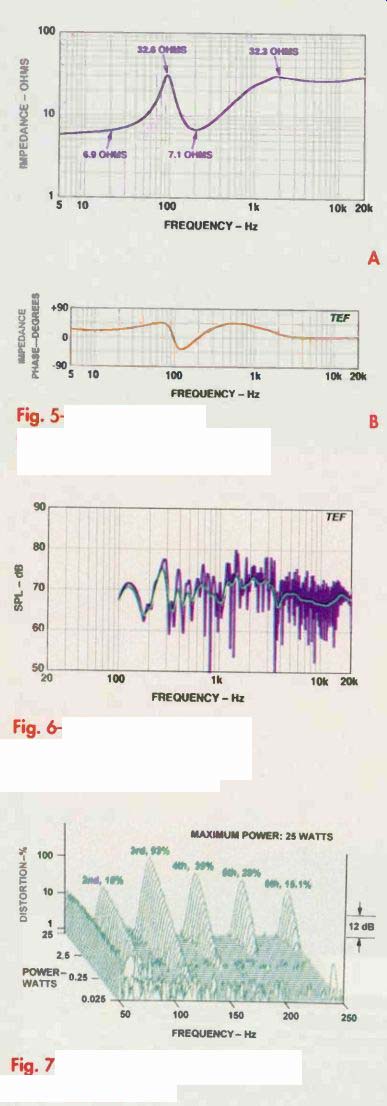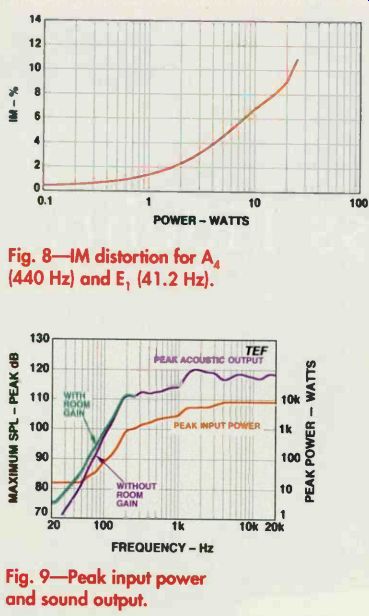
---------
Rated Room Frequency Response: 55 Hz to 20 kHz, ±3 dB.
Rated Sensitivity: 84 dB at 1 meter, 2.83 V rms applied.
Impedance: 8 ohms, nominal.
Recommended Amplifier Power: 50 to 200 watts per channel.
Dimensions: 10 in. H x 5 1/2 in. W x 6 1/2 in. D (25.4 cm x 14 cm x 16.5 cm).
Weight: 6 lbs. (2.7 kg) each.
Price: $695 per pair in satin black, $795 per pair in walnut; single-wire version (Model 10), $595 per pair in satin black or white.
Company Address: P.O. Box 326, Garden City, N.Y. 11530; 516/486-8285.
----------
Dr. Erol Ricketts has received many awards as an expert in urban poverty and public policy (about which he's written a book) and the spread of venereal disease and AIDS. And since 1991, he's been president of NSM Loudspeakers, a high-end company he founded and named after his children, Nsombi, Sekou, and Makeda. The company now makes more than 10 speaker models, ranging in price from $495 to $6,495 per pair. NSM also manufactures sand-filled speaker stands, called Sandbags (30-inch Matador stands, which cost $295 per pair, were supplied for this review), and a line of amplifiers under the GREO brand name.
The Model 10S is the smallest (though not the least expensive) speaker NSM manufactures. Although the 10S speakers were submitted for review as stand-alone systems, the company primarily intends them for use with a companion subwoofer, the Model 15-EXP.
The 10S is a two-way, closed-box design. Its cabinet, tightly constructed of half-inch MDF, is strengthened with an internal shelf that divides the enclosure into two equal parts. A large hole in the shelf lets the woofer use all of the box's internal volume. The cabinet is finished on all six sides. The grille frame, of molded plastic, is covered with black grille cloth. The grille attaches to the front of the enclosure via four pegs that mate with rubber-lined holes in the corners of the cabinet's front panel.
The drivers are centered on the front of the cabinet, with the tweeter above the woofer, and are flush with the cabinet. The tweeter's large faceplate keeps the centers of the tweeter and woofer separated by a significant 4 1/2 inches. The 1-inch soft-dome tweeter is magnetic-fluid cooled and incorporates a large ferrite magnet, 3 inches in diameter and 0.6 inch thick. The 4 1/2-inch woofer is a long-throw unit. Its inch-diameter voice coil is attached to a molded-plastic cone with rubber surround; its magnet is the same size as the tweeter's.
The crossover is a minimalist design, containing only three components. A hefty 3.1-millihenry air-core inductor, wound with large-diameter wire, is in series with the woofer, and a series combination of a high-quality, 5-microfarad capacitor and 24-ohm power resistor drives the tweeter. These components form first-order (6 dB/octave) high- and low-pass filters. The series resistor effectively attenuates the tweeter level to match the woofer's relatively low sensitivity. The crossover is mounted on a small piece of fiberboard attached to the back of the cabinet, behind the tweeter. The NSM's internal connections are soldered and use audiophile-grade, large-diameter stranded wire. Connections to the speaker are through a pair of gold-plated, audiophile-grade terminals on the cabinet's bottom rear. (You may bi-wire the terminals; a single-wire version, the Model 10, is avail able.) Standard double-banana jacks and cable up to 0.3 inch in diameter (AWG #2!) are accepted.
Measurements
I measured the NSM Model 10S's anechoic frequency response (Fig. 1) at a distance of 1 meter from the front of the cabinet and used a tenth-octave filter to smooth the curves. The top curves, taken without the speaker's grille, show the response at two locations: on the tweeter's axis, which yields a quite rough response through the crossover region, and at a point even with the bottom of the cabinet (the woofer end), which yields a much flatter response.

Fig. 1-On-axis frequency response.
Fig. 2-On-axis phase response, group delay, and waveform phase (see text).
Fig. 3-Horizontal off-axis frequency responses.
Fig. 4-Vertical off-axis frequency responses.
I experimented with different measurement locations because of the poor response I obtained on the tweeter's axis. That curve has an octave-wide hump of about 4 dB centered at about 2 kHz and a narrower, 7-dB dip at 5 kHz. If you exclude this hump and dip, however, the curve is fairly flat. To explore why this curve was so poor, I re measured the response but re versed the tweeter connections. (I could do this easily by changing the speaker's bi- wire connections.) The curve (not shown) exhibited a significant reduction in level be tween 1 and 4 kHz but had much higher output between 4 and 8 kHz. This indicates that in the nor mal connection, the woofer and tweeter are approximately in phase in the lower frequency range but are significantly out of phase in the upper range, which can yield poor vertical coverage. The out-of-phase condition was responsible for the dip at 5 kHz. The wide range of interaction between the woofer and tweeter (the three octaves from 1 to 8 kHz) is a result of the gradual rolloffs of the speaker's first-order crossover and the drivers' consequent broad, overlapping responses.
I searched for other measurement locations that would yield flatter response through the crossover region when the drivers were connected in normal polarity and also yield a reduction in response through the same region when the drivers were connected in reverse. I obtained the desired results when I measured the 10S on the woofer's axis (or lower), at a point even with the bottom of the cabinet. The response (Fig. 1, top curve set) is much smoother than on the tweeter's axis. The hump at 2 kHz is reduced, and the dip at 5 kHz has disappeared. On this new axis but with the tweeter's connection reversed, there was a reduction of some 5 to 15 dB from 1 to 8 kHz (response not shown), which is a good sign. Having the drivers more nearly in phase through the crossover range minimizes lobing and improves vertical coverage.
The 12-dB/octave rolloff in the bass is normal behavior for a closed-box speaker system. In the NSM 10S, this rolloff begins at a fairly high frequency (180 or 80 Hz, de pending on whether you count its beginning from the slight upper-bass peak or from the-3 dB point relative to 1 kHz), but that would be inconsequential if the 10S were used with a subwoofer.
The lower set of curves in Fig. 1 demonstrates the effect of the speaker's grille. The grille significantly roughens the response above 2.5 kHz.
Averaged from 250 Hz to 4 kHz (with equal emphasis on each third-octave frequency band), the 10S's sensitivity was a very low 80.7 dB, about 3 dB below NSM's low, 84-dB, rating. The right and left speakers matched within a very close ±0.5 dB from 100 Hz to 20 kHz.
Figure 2 shows the phase and group-delay responses, referenced to the tweeter's arrival time. The phase curve is very well behaved and decreases only 90° between 1 and 10 kHz. When averaged from 1 to 4 kHz, the group-delay curve indicates a low offset of about 0.15 millisecond, with the woofer delayed relative to the tweeter.
Also shown in Fig. 2 is the waveform phase, which indicates whether waveshapes will be preserved in specific frequency ranges. In previous reviews, I have plotted waveform phase on a wrapped ±180° scale. However, here the graph shows the absolute value of the waveform phase, plotted on a scale from 0° to 180°. This eliminates the sharp transitions when the phase rotates from 180° to +180°. If the waveform phase is at or near 0° over a specific frequency range and the frequency response is relatively flat over that range, wave forms will be preserved (and will be in proper polarity) if the signal's energy is constrained to that range. Likewise, if the waveform phase is at or near 180°, wave shapes will be preserved but inverted. For the NSM 10S, the curve of waveform phase indicates that waveshapes in the woofer's range from 300 Hz to 2.5 kHz will be somewhat preserved but will be inverted, while signals whose energy is constrained to higher and lower frequencies will come through in proper polarity. Odd as it may sound, this actually represents unusually good performance on the waveform phase test. Interestingly, when I examined the drivers' crossover connections, I found that the woofer was connected in reverse polarity and the tweeter in normal polarity.

Fig. 5-Impedance magnitude (A) and phase (B).
Fig. 6-Three-meter room responses.
Fig. 7-Harmonic distortion for E1 (41.2 Hz).
Figure 3 shows the speaker's horizontal off-axis responses. (The bold curve at the rear is on-axis response.) The curves here and in Fig. 4 were obtained by rotating the speaker around the woofer's axis and measuring 1 meter in front of the 10S. The curve-to curve uniformity in Fig. 3 indicates very even horizontal cover age; from 10 to about 18 kHz, only moderate narrowing is evident.
The 10S's vertical off-axis responses are shown in Fig. 4. (The bold curve in the middle of the graph was taken on the woofer's axis.) In the important range from on-axis to 15° above axis, the curves are quite uniform except for a dip between 4.5 and 7 kHz (which corresponds to the dip in Fig. 1 in the response taken on the tweeter's axis). At downward angles in the same range, a broad depression between 1.8 and 7 kHz develops not far below the axis (not clearly seen in the graph). At angles far above the speaker's axis, a sharp dip develops at about 1.3 kHz. The vertical responses are quite asymmetrical, with the curves above axis much better than those below it.
At low frequencies, the NSM's impedance magnitude (Fig. 5A) exhibits the classic characteristic of a closed-box loud speaker-a single peak. Here, the peak is at 90 Hz, the resonant frequency of the woofer in the closed box. At higher frequencies, the impedance reaches a minimum of 7.1 ohms at 200 Hz and then rises smoothly to about 32 ohms above 1.4 kHz. The high impedance at high frequencies is directly due to the crossover's resistor in series with the tweeter. Between 20 Hz and 20 kHz, a 32.6-ohm maximum occurs at 90 Hz and a moderately low minimum of 6.9 ohms at 20 Hz.
The max/min impedance variation is thus a moderate ratio of 4.7 to 1 (32.6 divided by 6.9). Cable series resistance should be limited to a maximum of about 0.1 ohm to pre vent cable-drop effects from causing response peaks and dips greater than 0.1 dB.

Fig. 8-IM distortion for A4 (440 Hz) and E1 (41.2 Hz).
Fig. 9-Peak input power and sound output.
For a typical run of about 10 feet, therefore, you should use 16-gauge (or larger), low-inductance cable with the NSM 10S. The impedance phase (Fig. 5B) stays within a moderate ±45° over the entire frequency range. Above 2 kHz, the phase is essentially 0°, which indicates a resistive load.
The 10S should be no problem for any amplifier, and solid-state amplifiers should have no difficulty handling a pair of these speakers in parallel.
When I subjected the 10S to a high-level sine-wave sweep, the cabinet exhibited minimal side-wall vibrations. The maxi mum linear excursion of the woofer was about 0.25 inch, peak to peak; the absolute maximum excursion (with high third-harmonic distortion) was about 0.3 inch, peak to peak. I could not detect any sign of dynamic offset.
Figure 6 shows the 10S's 3-meter room response, with both raw and sixth-octave-smoothed data. The speaker was upright in the right-hand stereo position, mounted on the supplied 30-inch stand, and aimed laterally at the test microphone. I raised the front of the cabinet by about 3/8 inch so that the test mike was even with its bottom. The system was driven with a swept sine-wave signal of 2.83 volts rms (corresponding to 1 watt into the speaker's rated 8-ohm impedance). The direct sound and 13 milliseconds of the room's reverberation are included. If you exclude the range below 340 Hz, the smoothed curve fits a moderately tight, 7.5-dB window. This curve's distinguishing features are many small undulations, a dip at 190 Hz followed by a peak at 270 Hz, and a broad rise between about 1.2 and 3.4 kHz. Above 4 kHz, the curve fits a very tight, 3-dB window.
Figure 7 shows the Model 10S's E1 (41.2-Hz) bass harmonic distortion; input power ranged from 0.025 to 25 watts (14.14 volts rms into 8 ohms). Even at the relatively low 25-watt input power level, the third harmonic reaches a very high 93%; this indicates hard symmetrical limiting in both directions of woofer excursion. Other results include 15% second harmonic, 39% fourth, 28% fifth, and 15% sixth. Clearly, this speaker is being overloaded by this amount of power at 41.2 Hz. Although the distortion at the E1 tone was quite high, the speaker handled the overload well and did not sound excessively distressed.
The A2 (110-Hz) bass harmonic distortion (not shown) rose to only moderate levels-- 100 at a 25-watt input. The maximum distortion was 8.9% second harmonic, with only 4.0% third and 2.7% fourth. The A4 (440-Hz) harmonic distortion (also not shown) rose only to the low level of 1.6% second harmonic; higher harmonics were below the floor of my analyzer. It is obvious from the differences between the 41.2-Hz and 110-Hz distortion readings that the 10S would benefit greatly from being used with a subwoofer.
Figure 8 shows the IM versus power created by tones of 440 Hz (A4) and 41.2 Hz (E1) of equal power, over the range from 0.1 to 25 watts. The IM rises gradually and reaches 11% at full power. Al though moderately high, 11% is a relatively low IM level for a speaker of this size that reproduces both tones from the same driver.
Figure 9 reveals the 10S's short term peak-power input and output capabilities. (The peak input power was calculated by assuming that the measured peak voltage was applied across the rated 8-ohm impedance.) The peak input power starts at a moderate 12 watts at 20 Hz, stays constant until 50 Hz, and then rises rapidly. It crosses 100 watts at 120 Hz and 1,000 watts at 300 Hz before leveling off at 6,000 watts above 4 kHz, in the tweeter's range. With room gain, the speaker's maximum peak SPL starts at an unusable 74 dB at 20 Hz and then rises rapidly. It crosses 90 dB at 60 Hz, 100 dB at 105 Hz, and 110 dB at 180 Hz before rising into the loud range of 115 to 119 dB SPL above 1.1 kHz. Although the 10S will play sufficiently loud above 180 Hz, its bass output is rather anemic; it is at the bottom of the list of all systems I have tested. However, the 10S is also the smallest speaker I've tested for Audio, and its low-frequency output competes favorably with that of other speakers in its size range I have used.
Use and Listening Tests
The NSM 10S speakers arrived at my lab packed two to a box, in a carton whose size seemed more appropriate for a single small system. The diminutive size of the Model 10S must be seen to be appreciated. Al though I could easily carry a pair under one arm, subjectively these speakers seemed quite substantial and weighty for their size. My review samples were finished in walnut, and their appearance and construction pro claimed a very upscale quality. Everything fit very well, including the grilles. Even the large, gold-plated bi-wirable terminals were worthy of the best high-end system.
For my listening tests, I mounted the NSMs on the 30-inch-high Matador stands. These stands, which must be assembled, came in a box more than twice the size of the speaker carton. And at nearly 20 pounds, each sand-filled stand weighs more than three times the speaker it supports! Each stand had four screw-in adjustable spikes, which came in quite handy when I needed to change vertical aiming. When the 105 is mounted on the Matador, the speaker's tweeter is approximately at ear height for a seated listener (37 inches).
The owner's manual goes into reasonable detail about unpacking, break-in, connections, bi-wiring, placement, use with subwoofers, and amplifier requirements. For best imaging, NSM suggests placing the systems on 30-inch stands, 2 feet or more from any walls, and about 8 feet apart. (My usual speaker locations conform to these guidelines.)
Hooking up the NSMs was a breeze, be cause their terminals are large and very accessible. I did not bi-wire them; instead I used supplied gold-plated straps. I connected the speakers to a Krell amp with Trans parent Audio's Music Wave Reference cables. Other listening components included Onkyo and Rotel CD players, Krell's KRC preamp, and B&W's 801 Matrix Series 3 speakers for comparison.
I placed the NSMs in my customary positions: about 8 feet apart, well away from walls, and aimed toward my listening position (10 feet away). I conducted the listening tests both before and after the bench tests. One valuable piece of knowledge I gained from the measurements was that the NSM's response could be improved by raising the speaker's axis so that a line extended from the bottom of the enclosure intersected my ear. To accomplish this, I tilted the stand backward and adjusted its spikes so that the stand's bottom was about 1/4 to 1/2 inch higher than the rear. This adjustment provided an audible improvement when I was seated, and most of the following comments apply to the tilted-back configuration.
First listening to the NSMs revealed excellent imaging, smooth and extended highs, and a much bigger sound than the speakers' size would suggest. However, their bass out put was quite restricted compared to that of larger systems, and their sensitivity was significantly less than that of the B&W 801s. The B&Ws needed some 6 to 7 dB of level reduction, depending on the program material, to match the NSMs' acoustic output.
When I listened to jazz and pop that had significant bass, such as kick drum or bass guitar, the 10S speakers could not be turned up very loud before being overloaded in the bass range. On the title track of Dave Grusin's Mountain Dance (GRP GRD 9507), for example, I could turn these speakers up only to about 80 to 85 dB SPL before exceeding the woofers' linear excursion range. At this level, the output was quite satisfying, however; everything except the bass sounded very good.
On program material that had less bass content, the NSMs could generate much louder levels. On Benedetto Marcello's Four Sonatas and a Concerto for Harpsichord (Jecklin-Disco JD 5001), the NSMs generated a very usable 90 to 95 dB SPL before starting to sound congested. On their own, the 10S speakers are much better suited to this kind of music. They made the harpsichord sound convincingly alive, producing a full and well-balanced sound.
On other classical chamber music, such as Dvorak's The Piano Quintets (Dorian DOR-90221), the Model 105 speakers presented a very solid and well-defined soundstage. The strings sounded quite convincing and realistic, and room ambience was excellent. The NSMs also did quite well on larger-scale symphonic works, but only if I restricted them to moderate to low levels. The low end of the NSMs sounded quite light weight compared to that of the B&Ws.
Since NSM primarily intends these speakers for use with a subwoofer, I also tried them with a Velodyne subwoofer connected to one channel. For simplicity's sake, I kept the NSMs connected directly to the power amp, which meant that no high-pass filtering was provided. I was pleasantly surprised by how much the additional bass improved the sound, even though the acoustic output of the NSMs was, obviously, unchanged.
On pink noise, the NSMs exhibited significant tonality, primarily an emphasis of the upper midrange. The lower two octaves of bass (the characteristic bass rumble of pink noise) were missing. These systems did do fairly well on the stand-up/sit-down test, exhibiting only moderate midrange tonal changes when I stood up. On third-octave band-limited pink noise, no usable output was produced at the 20-, 25-, 32-, and 40-Hz bands. At 50 and 63 Hz, there was some usable output, but these speakers could not be played very loud before they generated high levels of third-harmonic distortion.
From 80 to 125 Hz, the usable output was much better, but I noticed a tendency to overload at high levels. On higher bands the output was quite acceptable. When I moved the LOS speakers closer to the wall behind them, the lows improved but at the expense of smoothness at higher frequencies.
On female vocals, the NSMs presented a significantly more forward sound than the B&Ws. Sibilants were reproduced properly, with no undue emphasis, and the overall sound was otherwise well balanced. On male speaking voice, I judged the NSMs' performance to be slightly better than that of the B&Ws. In my listening room, the 801s have a tendency to add some chestiness to male voice; the NSMs didn't do that.
If you need a very small speaker that has great looks and offers solid performance, consider the NSM Model 10S. A pair would work well in a small room or would be a fine choice as satellites coupled with a subwoofer.
-D. B. KEELE, JR.
(Source: Audio magazine, Apr. 1996)
Also see:
Ohm Acoustics Corp. (ad, Sept 1973)
M&K Satellite-1A and Volkswoofer-A Loudspeakers (Apr. 1982)